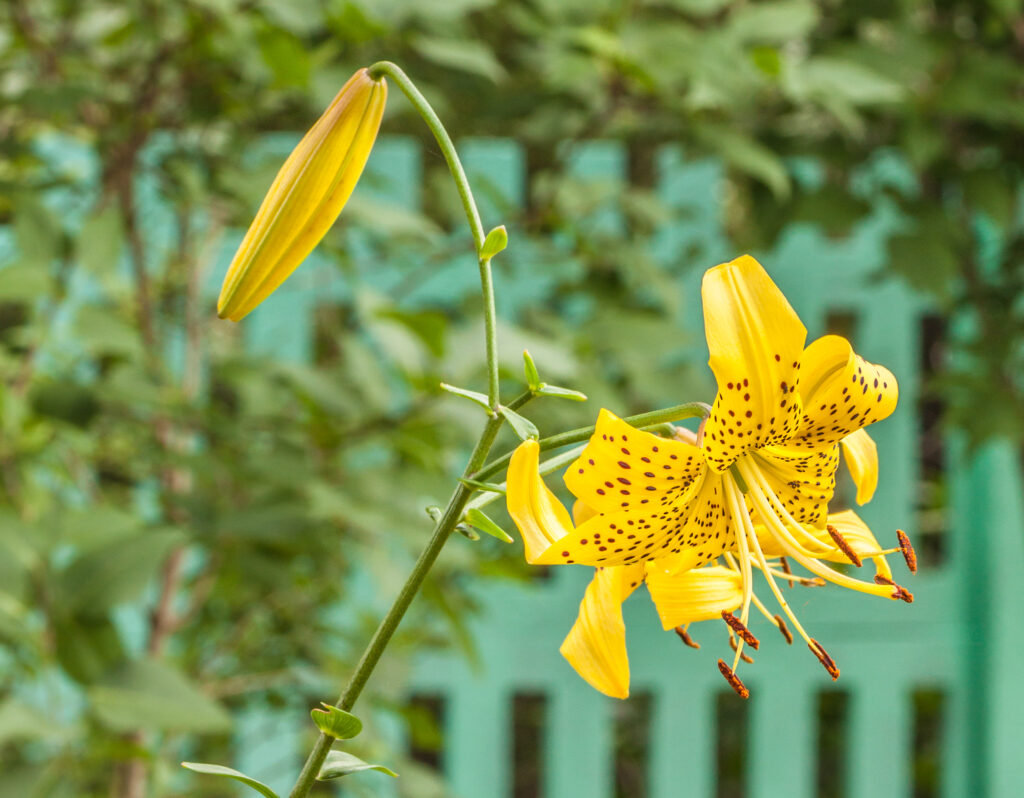
The tiger lily (Lilium lancifolium) is a vibrant Asian lily species that belongs to the genus Lilium. Known for its striking orange blooms and black or crimson spots, this low-maintenance flower is the perfect fit for any garden. In many cultures and religions, tiger lily symbolism is tied to confidence, compassion, and virtue. In fact, in Buddhism, many view the tiger lily as a sign of mercy and compassion.
The herbaceous perennials are native to China, Japan, Korea, and the Russian Far East. However, they are now naturalized across the United States and worldwide.
Today, many view tiger lilies as prolific, easily maintained flowers that boast vibrant and colorful blooms. Their bright orange petals and unique flowers (which curve backward) remind us that it’s okay to take up space and shine our light.
There are 80 to 100 accredited tiger lily species, some of which come in different colors like pink, yellow, red, cream, and white. However, the popular tiger lily is best known for its orange flowers, dark spots, and curved petals.
There are many different meanings for the tiger lily, spanning across various cultures and religions. Keep reading to learn some of the exotic flower’s most popular symbolism, plus some care tips and special facts.
What Is a Tiger Lily?
The herbaceous perennial tiger lily is known for its bright-colored blooms with unique markings. These flowers bloom during the summer (between early May and August), signaling the start of summer. They can thrive indoors and outdoors, depending on your location in the USDA Plant Hardiness Zone. For the most part, tiger lilies are low maintenance and simply require well-draining, moist soil and indirect sunlight.

Tiger lilies add the perfect pop of color and positive energy to any space.
©Roig61/Shutterstock.com
Appearance
When in bloom (during late spring and throughout summer), tiger lilies grow flowers that are often bright in color (most commonly orange, yellow, or red, but sometimes pink, white, or cream). Their petals curve backward and have crimson or black dots, making them easily distinguishable in comparison to other lilies. The plant itself grows between 8 to 5 feet tall and 7 to 8 inches wide and produces about ten flowers per stem.
Native Habitat
Tiger lilies are an Asian species of the lily family (Liliaceae) and are native to China, Japan, Korea, and the Russian Far East. The plant was naturalized and can now be found across the U.S., especially in New England or areas with mild summers. They were originally introduced as ornamental garden plants.
Growing Tips
Blooming from early May to August, tiger lilies are easy to maintain and do best in locations that fall into Zones 3 to 9. The flower prefers full to partial shade in warmer climates. They can handle full soon in cooler climates, but otherwise, the direct sunlight can scorch their leaves.
Additionally, tiger lilies require well-draining, slightly-acidic soil that’s kept moist at all times. To grow them, you’ll want to plant their bulbs during late summer or early autumn (late August to late September). Bulbs should be 4 to 6 inches deep and 6 to 8 inches apart from one another. This will ensure they have plenty of room to grow without any overlapping.
In terms of climate, tiger lilies do best in moderate temperatures between 60 degrees Fahrenheit to 75 degrees Fahrenheit. Extreme heat and extreme cold can stunt their growth or even kill the plant altogether.
Most tiger lilies will do just fine without any sort of fertilizer. In fact, using compost once or twice a year should be enough. However, If you want to purchase fertilizer or promote more flowering, look for 5-10-5 fertilizer. Additionally, before summer hits and the plant blooms, consider adding mulch to the soil to protect the tiger lilies’ roots from overheating.
Can Tiger Lilies Be Grown Outside?
Yes, you can grow tiger lilies outside. As mentioned above, they do best in cooler climates with temperatures between 60 degrees Fahrenheit and 75 degrees Fahrenheit. However, they can tolerate below-freezing temperatures and temperatures in the 90s.
With the right garden soil and sunlight, tiger lilies can make the perfect addition to your outdoor garden, as they’re extremely low-maintenance. Just keep the soil moist and be sure not to allow the leaves to scorch in direct sunlight (mainly in locations of higher zones).
Tiger Lily Meaning and Symbolism
With its striking appearance and vibrant colors, the tiger lily embodies positive themes and associations. Read on to learn more about the specific symbolism of tiger lilies.

The tiger lily carries positive spiritual, cultural, and religious meanings.
©Sarycheva Olesia/Shutterstock.com
Health and Healing
A tiger lily bulb is actually an anti-inflammatory, diuretic, emenagogue, emollient, and expectorant. They can treat various diseases, from those affecting the heart to those impacting the eye. In fact, they’re known to strengthen eyelid muscles, especially in the case of myopic astigmatisms. In Asia and Japan, the bulb is edible and can be eaten raw or cooked. The flavor often resembles turnips.
Because of its medicinal uses, many associated the flower with health and healing — physical, spiritual, mental, and emotional.
Confidence and Magnetism
Due to its bold appearance, the tiger lily reminds us to embrace and radiate our true selves. The more confident we are, the more positivity we will attract. Just like the tiger lily basking in all its beautiful glory, when we stand tall and let ourselves blossom, we shine in ways we might not have known were possible. This confidence often manifests magnetism, making our energy irresistible to others.
Mercy and Compassion
In Buddhism, tiger lilies symbolize the virtues of mercy and compassion. They’re a great emblem of forgiveness for others and ourselves, as they allow us to show mercy for our own wrongdoings and express compassion to those who have hurt us. We all make mistakes in life; without mercy, we wouldn’t be able to learn and grow from our past. The tiger lily reminds us to practice empathy for all humankind.
Strength and Resilience
Tiger lilies are hardy plants that can survive both below-freezing temperatures and those above 90 degrees Fahrenheit. Their bulbs survive through the winter and promise gorgeous blooms when flourishing throughout summer. As a result, they symbolize strength and resilience — the ability to withstand challenging conditions. Regardless of the extremes of their environments, they still emerge brighter and more vibrant than ever.
Wealth and Prosperity
Especially in Japan and China, tiger lilies represent fortune and wealth. In fact, this seemingly holy flower is a symbol of wealth and prosperity across various cultures, promising luck to those who grow their own garden of tiger lilies or indoor tiger lily plants. If you want to manifest abundance, consider purchasing your own tiger lilies for your home or yard.
Pride and Joy
In the Victorian era, many believed tiger lilies represented modest pride — with the absence of vanity. These gorgeous flowers symbolize happiness for someone’s achievements, showcasing the pride we feel in ourselves and our loved ones. That’s why they’re often gifted to others to express how proud you are of them for reaching recent success or enduring hardship.
Spiritual Significance
Tiger lilies actually represent spirituality in many religions and cultures. In fact, the flower itself is said to help you connect with your spiritual self and harness your intuitive powers. The tiger lily can act as a spiritual protection from negative energies and add a sense of positivity to your space.
Whether you’re purchasing a tiger lily for your own home or gifting the plant to a loved one, its beauty and symbolism are sure to impress.
Thank you for reading! Have some feedback for us? Contact the AZ Animals editorial team.








